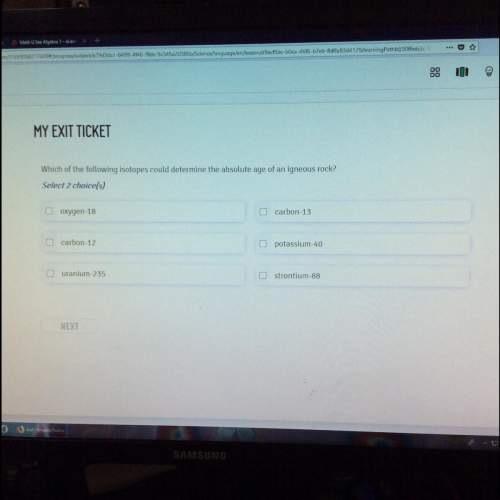Carbon in the atmosphere (CO2)
Carbon in plants and animals
It must move through at le...

Biology, 07.12.2021 22:00, emily41950
Carbon in the atmosphere (CO2)
Carbon in plants and animals
It must move through at least 5 different living things (plants/animals) - be sure that the plants/animals would actually interact with each other in nature (ex no african lions eating arctic foxes) this may require a bit of research.
Extra credit - show it becoming fossil fuels and the fossil fuels being burned to release CO2 back into the atmosphere.
In plants/animals- either how its stored in the plant/animal then the plant/animal being eaten or the steps of cellular respiration
In plants- the steps of photosynthesis (how it goes from being CO2 to glucose)
Paragraph / written story

Answers: 1
Other questions on the subject: Biology


Biology, 22.06.2019 01:10, 21hendlill
Advances in technology have enabled scientists and researchers to better study the evolutionary relationships between species
Answers: 3

Biology, 22.06.2019 14:40, breniljakenotro
Both destructive and constructive, the natural event seen here, is important in destroying and creating landforms on earth. what is this event called? a) deposition b) flooding c) landslide d) sedimentation
Answers: 2

Biology, 22.06.2019 19:20, Bradgarner772
What is the relative placement of the moon, earth and sun during a lunar eclipse? the sun, earth and moon are aligned with the earth in the middle and the moon furthest away from the sun. the moon and sun are aligned with the earth at right a right angle to the moon. the sun, earth and moon are aligned with the moon in the center and the earth furthest away from the sun. the earth and sun are aligned with the moon is at a right angle to earth. 2. choose the best explanation of a partial solar eclipse. during a new moon phase there is usually a partial but not total eclipse. the earth only partially covers the sun during the eclipse. the moon only partially covers the sun during the eclipse. the moon only partially covers the sun during the eclipse. the moon's phase is full and blocks out most but not all of the sun. 3. what are conditions necessary for a total solar eclipse? moon in perigee orbit, earth a direct line between sun and moon, moon in full moon phase moon in perigee orbit; moon moves a direct line between sun and earth; moon in full moon phase moon in perigee orbit; moon moves a direct line between sun and earth; moon in new moon phase moon in apogee orbit, moon moves a direct line between sun and earth; moon in new moon phase 4. what causes a partial lunar eclipse? only the penumbra of the earth passes across the moon creating a circular shadow. the earth's umbra fits inside the moon creating an illuminated ring known as a annular eclipse. a partial eclipse causes the moon to turn reddish from the refraction of the sun's ray through the earth atmosphere. the earth's umbra only cover a part of the moon causing a circular shadow to pass across it.
Answers: 1
Do you know the correct answer?
Questions in other subjects:








Computers and Technology, 23.01.2020 04:31








